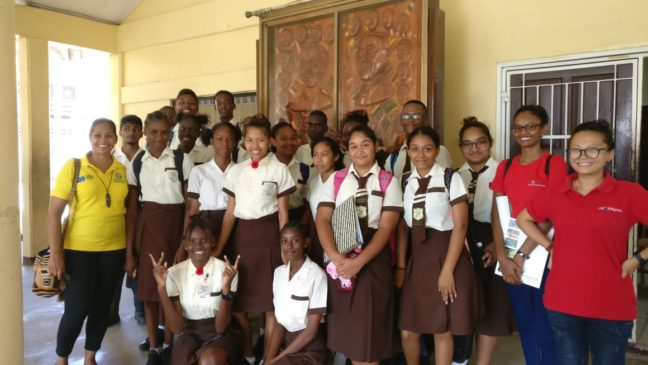
As part of its annual school outreach programme, a team from the Iwokrama International Centre visited students of the Kingston, Tutorial and Dolphin’s High Schools and the Ptolemy Reid Centre last week
According to a release from the organisation, as it relates to the high schools, the Iwokrama team interacted with higher-level students who hail from the agriculture, science and arts streams.
The aim of the initiative is to enlighten students across the country about Guyana’s rich biodiversity and how they can play a part in protecting it.
The outreach informed the students about the country’s protected areas; the Iwokrama Forest, the Kanuku Mountains, Shell Beach, the Kaieteur National Park and the Konashen Amerindian Protected Area – which is home to the country’s most remote Indigenous tribe, the Wai-Wais.
The students, according to the release, were amazed to learn various fascinating details like the country’s oldest protected area is the Kaieteur National Park, which was established in 1929.
They were also given a brief history of Iwokrama and the work it does in the areas of sustainable forestry management, research and tourism.
In highlighting the significance of the Iwokrama Forest Reserve, Dr Thomas-Caesar explained that it lies within the heart of the Guiana Shield – which is one of the of only four remaining large tracts of intact rainforest ecosystems in the world.
The students were also enlightened about the importance of protected areas to the global ecosystem.
As such, Dr Thomas-Caesar, Director, Resource Management and Training, charged the students to be guardians of their environment.
In one instance, she encouraged them to speak out against littering. She explained the harmful effects of improper garbage disposal, especially for marine animals like sea turtles who mistake plastic in the oceans for food.
Caren Wilfred, organiser of the school outreach and tourism staffer, in her presentations to the students, spoke about proper solid waste management. She reiterated the dangers of littering, such as pollution to the airways and waterways. In addition to posing health threats, littering can block the drainage system and can lead to severe flooding, she explained.
Biologist, Huichang Yang sought to encourage students to pursue a career in biology, as she delved into the exciting aspects of working at Iwokrama.
She underscored the importance of protecting animals, and showed students some of the activities which are undertaken right at Iwokrama to ensure these animals are protected.
Moreover, she spoke about the importance of the Iwokrama Forest to the country’s biodiversity.
She highlighted that of the 225 species of mammals in Guyana, some 130 are found at Iwokrama; of the 814 species of birds in the country, 476 are found at Iwokrama; of the 176 species of reptiles, 82 are found at Iwokrama; of the 148 amphibians, 59 are found at Iwokrama; of the more than 800 species of fish, 400 are found at Iwokrama; and of the more than 8000 species of plants, 1250 are found at Iwokrama.
These figures, she explained, are based on 2005 data.
Therefore, to date, the numbers may be significantly higher.
Some Tutorial High School students expressed an interest in setting up their own environmental club and the Iwokrama team committed to provide assistance in the establishment of the club.
Further, the Iwokrama team handed over several informative materials to all the schools visited, including guides to the birds, mammals and plants of Iwokrama and educational posters.
According to the release, Iwokrama will be reaching out to other secondary schools such as Charlestown, Central High, St John’s College, North Georgetown and Christ Church. A session will also be held with The Blind Society.
This is an annual activity but this year it has extra significance as the Iwokrama International Centre celebrates its 30-year commemoration of the pledge of the one million-acre Iwokrama Forest to the international community for research and development as it relates to tropical rain forests.



